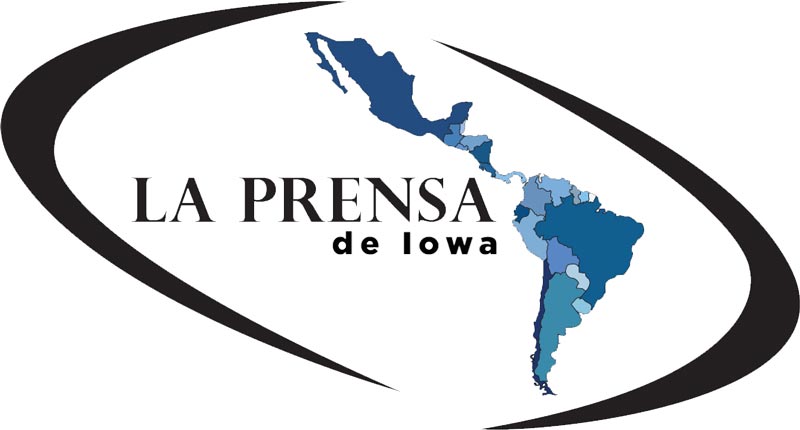Las duras condiciones invernales se sienten en algunos lagos de Iowa
/English translation provided at the end.
LA PRENSA
Redacción
A medida que más nieve y duras temperaturas dominan el pronóstico en Iowa, el comienzo suave del invierno es un recuerdo lejano. Más de dos pies de nieve se asientan en muchos lagos y estanques del norte de Iowa con 20-24 pulgadas de hielo debajo de toda esa nieve.
El lago congelado de Storm Lake, Iowa.
Las fuertes nevadas sobre el hielo bloquean la luz solar para que no alcancen las plantas acuáticas y evitan que produzcan oxígeno. Esta combinación puede crear condiciones de bajo oxígeno que pueden llevar a la muerte de peces.
Las muertes de peces en el invierno son comunes en los lagos poco profundos de Iowa durante los inviernos largos con mucha nieve. Los cuerpos de agua más grandes con mayor profundidad tienen más volumen, lo que les permite tolerar largos períodos de hielo y nieve.
Algunos lagos públicos y estanques privados tienen sistemas de aireación de invierno que mantienen agujeros abiertos. Los sistemas de aireación no inyectan oxígeno en el agua, simplemente crean áreas abiertas donde los gases pueden difundirse en la interfaz agua y aire y crear refugio.
Estos sistemas dependen del tamaño del área de aguas abiertas para maximizar la efectividad. El Departamento de Recursos Naturales (DNR) de Iowa tiene sistemas de aireación en diez lagos naturales.
Las condiciones de hielo variables y peligrosas a principios de este invierno impidieron que los funcionarios estatales activaran algunos sistemas en diciembre y enero. Se iniciaron algunos sistemas y luego se apagaron después de que grandes porciones del lago volvieran a abrirse.
Mike Hawkins, biólogo pesquero del Departamento de Recursos Naturales de Iowa en Spirit Lake, dice que las condiciones de hielo hasta finales de enero fueron peligrosas. “Los agujeros abiertos y las áreas débiles nos impidieron encontrar un momento seguro para iniciar los aireadores”.
“El aireador en Clear Lake se inició en diciembre y luego se cerró porque causó que una gran parte del lago se abriera de nuevo durante el clima ventoso y suave”, dice Scott Grummer, Biólogo de Pesca en Clear Lake.
Hawkins y Grummer decidieron no reiniciar varios de sus sistemas de aireación después de que el hielo finalmente se solidificó en la mayoría de los lagos a fines de enero y principios de febrero.
“Tener agua abierta tan tarde en la temporada realmente acorta el tiempo en que los lagos se mantendrán cubiertos de hielo, lo que reducirá drásticamente la posibilidad de una muerte invernal”, dice Grummer.
Hawkins agrega que “tenemos que tomar una decisión difícil en una ventana muy corta. Siempre estamos sopesando la seguridad contra el riesgo de la próxima temporada. El agua alta, el hielo tardío y muy poca nieve a principios de este año se sumaron a un bajo riesgo de muerte invernal”.
Los equipos de DNR son responsables de colocar señales de seguridad en el hielo alrededor del agujero una vez que el sistema esté funcionando.
Los niveles de oxígeno disuelto se monitorean en los lagos naturales a lo largo del noroeste de Iowa y hasta ahora los niveles aún son seguros en la mayoría de los lugares. Los lagos naturales invernan de vez en cuando y forman parte del ciclo natural.
“Las especies de peces en estos lagos han evolucionado bajo estas condiciones y sus poblaciones generalmente se recuperan muy rápidamente. Algunos de los mejores lugares para pescar en estos lagos naturales poco profundos pueden ser de dos a tres años después de un invierno”, dice Hawkins.
Google Translation
As more snow and harsh temperatures dominate the forecast in Iowa, the soft start of winter is a distant memory. More than two feet of snow sits in many lakes and ponds in northern Iowa with 20-24 inches of ice underneath all that snow.
Heavy snowfalls on the ice block sunlight so they do not reach aquatic plants and prevent them from producing oxygen. This combination can create low oxygen conditions that can lead to the death of fish. Fish deaths in the winter are common in shallow lakes in Iowa during long winters with lots of snow. Larger bodies of water with greater depth have more volume, which allows them to tolerate long periods of ice and snow. Some public lakes and private ponds have winter aeration systems that keep holes open. Aeration systems do not inject oxygen into the water, they simply create open areas where gases can diffuse into the water and air interface and create shelter.
These systems depend on the size of the open water area to maximize effectiveness. The Department of Natural Resources (DNR) of Iowa has aeration systems in ten natural lakes. The variable and dangerous ice conditions earlier this winter prevented state officials from activating some systems in December and January. Some systems were started and then turned off after large portions of the lake were reopened. Mike Hawkins, a fisheries biologist with the Iowa Department of Natural Resources at Spirit Lake, says the ice conditions until the end of January were dangerous. "The open holes and weak areas prevented us from finding a safe time to start the aerators." "The aerator at Clear Lake started in December and then closed because it caused a large part of the lake to open again during windy, mild weather," says Scott Grummer, fisheries biologist at Clear Lake. Hawkins and Grummer decided not to restart several of their aeration systems after the ice finally solidified in most of the lakes in late January and early February.
"Having water open so late in the season really shortens the time the lakes will stay covered in ice, which will drastically reduce the possibility of a winter death," says Grummer.
Hawkins adds that "we have to make a difficult decision in a very short window. We are always weighing the security against the risk of next season. High water, late ice and very little snow earlier this year added to a low risk of winter death. " The DNR teams are responsible for placing safety signs on the ice around the hole once the system is running.
Dissolved oxygen levels are monitored in natural lakes throughout northwest Iowa and up to now levels are still safe in most places. Natural lakes winter from time to time and are part of the natural cycle.
"The fish species in these lakes have evolved under these conditions and their populations generally recover very quickly. Some of the best places to fish in these shallow natural lakes can be two to three years after a winter, "says Hawkins.







































